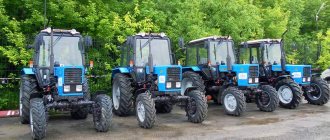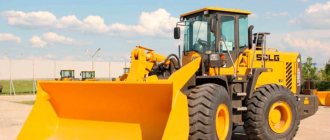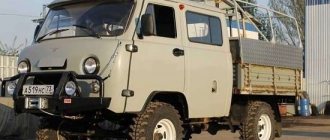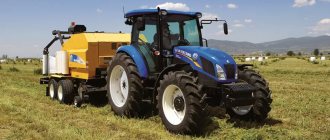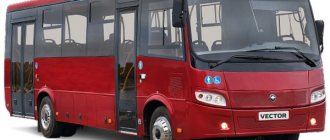- home
- Media center
- Articles
- Skid steer fuel consumption
Menu
- News
- Articles
- Video materials
- Photo materials
- Publication in the media
- 3D tour
27.07.2021
Skid steers are a fairly popular type of vehicle that is used for agricultural, warehouse and construction work. They are characterized by compactness and small dimensions, which gives them the opportunity to organize activities that differ from conventional forklifts.
The engines of mini loaders run on diesel fuel. Moreover, such equipment has reduced fuel consumption in the wheeled version compared to the tracked one. On average, the figures fluctuate in the range of 2.84-22 l/hour. The first wheeled format tends to the lower values, and the tracked one tends to the upper ones.
It should be noted that fuel consumption for different types of mini-loaders depends on classification features, as well as manufacturers of specific models of special equipment. Based on this, we will make a comparison, but first we will understand how this indicator is calculated.
Fuel consumption on forklifts
- Determination of specific fuel consumption.
- Calculate fuel consumption using the formula for a diesel forklift.
- Why doesn't the manufacturer always indicate the exact fuel consumption for a forklift?
In addition to the technical characteristics and functionality, the buyer of loading equipment is also interested in the issue of fuel consumption of this or that special equipment with an internal combustion engine. The costs of servicing a forklift, in addition to service stations and repairs, include fuel costs, which is reflected in the cost of work and goods. Fuel costs take up the majority of expenses for equipment maintenance. But, unlike a car, there are no clear standards for fuel consumption per 100 km for a loader. The manufacturer usually indicates this figure in grams per unit of power. Sellers of loading equipment, based on experience, tell the buyer completely different numbers, which may differ significantly from the indicators specified by the manufacturer. What's the matter?
This important issue needs to be addressed. To begin with, let us recall the formula for calculating fuel per 1 engine hour, which has the following form:
Q = N x q / 1000 x R x k1
Q - fuel consumption per engine hour
N - engine power in hp.
Q - specific fuel consumption
R - the density of diesel fuel is constant and equal to 0.85 kg/dm3
Let's try to determine other indicators of this formula. Engine power is indicated in the manufacturer's technical specifications for this loader and is measured in horsepower. Specific fuel consumption – has the form of remote fuel consumption curve data and depends on the engine type. This indicator is not indicated in the technical specifications, so it is best to find out from the equipment seller. The consultant or seller is required to have this data, since it is provided to him by the manufacturer. The specific indicator is calculated based on tests carried out with the engine in various modes. The most important role in this calculation is given to determining the coefficient k1. It is an indicator characterizing the operation of the engine at maximum speed. This figure is taken based on the individual operating mode of equipment at your enterprise. As a rule, in standard calculations the indicator is 2.33. That is, 100% is taken as the full working time, of which 30% of the engine operates at full power, so we get: k1 = 70%/30% k1 = 2.33.
S530
The Bobcat S530 mini loader has most technical parameters similar to the S175 model. The differences are greater productivity, the ability to work in hard-to-reach places, which is ensured by the vertical position of the lifting boom in the process of lifting, carrying and lowering the load.
The machine is equipped with:
- more powerful Kubota / V2403-MDI-E3B Interim Tier 4 engine with a volume of 2600 cm³ with liquid cooling and a power of 49 hp;
- has a mass of 2.82 tons;
- dimensions - 3.38 x 1.73 x 1.97 m;
- capable of lifting a load of 839 kg to a height of 3.02 cm;
- tipping load is limited to 1.68 t;
- the unit moves at a speed of 11.8 km/h;
- consumes 4.5-5.5 l/h of fuel during operation.
Disadvantages of gasoline-powered forklifts. How to reduce consumption
| Universal calculation of fuel consumption for a diesel forklift The warehouse equipment market offers a wide variety of models, which allows a variable approach to organizing the production process in a warehouse, taking into account the parameters of the cargo and the existing costs of processing it. Therefore, in practice, for more accurate calculations, it is advisable to use a formula that takes into account more factors, in particular the intensity of the operating mode and the nature of the loads being lifted. |
| How to find out the fuel consumption of a forklift per hour - table of fuel consumption standards for Toyota forklifts Thus, fuel consumption indicators are influenced by parameters such as engine power and specific fuel consumption, and the duration of working hours when it operates at maximum speed. The most important characteristic of the cost of ownership is fuel consumption; low consumption of diesel fuel significantly reduces the overall costs of the production process. |
- N is the power of the power unit;
- q is the indicator of specific fuel consumption of the loader;
- R is the density of the fuel (diesel). Usually taken at the level of 0.85 kg/dm3;
- k1 is the percentage ratio of the operating time at maximum crankshaft speed.
Advantages of gasoline-powered loaders • Diesel generators, gas piston and power plants, gas turbines, power plants and power plants are all Caterpillar.
Attachments
One of the differences between Bobket loaders and their analogues is the large number of attachments with which they can work.
Some of its types require the installation of additional control kits, re-equipping the cab with Lexan fencing, including a thicker front door (up to 1.2 cm), top and rear windows (0.6).
The list of attachments that ensure the versatility and versatility of mini loaders includes:
- grader for leveling work;
- a brush with bristles for sweeping areas;
- dump hopper;
- concrete pump for supplying concrete mixtures and mortar over a distance;
- vibrating roller for compacting base layers, coatings on sidewalks and roads;
- circular saw for cutting wood;
- rotary brush cutter for removing overgrown trees and overgrown shrubs;
- concrete mixing bucket for preparing concrete, cement-sand mixtures, mortars;
- toothed ripper for destroying asphalt concrete, crushed stone surfaces of roads and sidewalks;
- cold milling machine for mixing materials with cement and other binders when passing;
- backhoe;
- universal forks equipped with a grip;
- spreader of bulk material for sprinkling roads and sidewalks with de-icing materials;
- earth leveler for leveling slopes of earthen embankments;
- rotary cultivator;
- turf layer for laying lawns and strengthening slopes;
- industrial takeover;
- hydraulic hammer for destruction of monolithic foundations and coatings;
- rotary snow blower for removing snow on roads and sidewalks;
- trencher for laying cables and pipes;
- bulldozer knife, which is used to level crushed stone, sand, gravel;
- auger drill for constructing planting holes and foundation pits.
On the practical aspects of fuel consumption rates
In addition to the technical characteristics and functionality, the buyer of loading equipment is also interested in the issue of fuel consumption of this or that special equipment with an internal combustion engine. The costs of servicing a forklift, in addition to service stations and repairs, include fuel costs, which is reflected in the cost of work and goods. Fuel costs take up the majority of expenses for equipment maintenance. But, unlike a car, there are no clear standards for fuel consumption per 100 km for a loader. The manufacturer usually indicates this figure in grams per unit of power. Sellers of loading equipment, based on experience, tell the buyer completely different numbers, which may differ significantly from the indicators specified by the manufacturer. What's the matter?
Photo
The ergonomics of the workplace in the Bobcat S175 are particularly well designed. functionally, the manufacturer offers models with heating and a luxury dashboard. The operations performed do not impede the operator's visibility at all. A comfortable chair with armrests and a wide system of settings allows you to create optimal working conditions.
In addition to the Bobcat C175 model, a high-performance hydraulic motor and tires designed for use in difficult conditions are offered.
How to get the most accurate fuel consumption figures
The figures obtained using the above formula are transferred to the accounting department to document the volumes of fuel officially written off. But even this formula does not give absolutely accurate figures. The problem is that the indicator q - specific fuel consumption per unit of engine power - is simply impossible to accurately calculate taking into account the operating specifics. Therefore, to clarify such data, many manufacturers request information from their clients, who monitor fuel consumption in direct operating conditions. Thus, it is possible to minimize the fuel costs of the forklift, making the business more profitable.
Does your production or warehouse require affordable, modern used forklifts ? Our company has a wide fleet of warehouse equipment for loading and unloading operations of any complexity and intensity. also provide additional services in the form of a forklift operator, refueling and regular maintenance for the entire rental period . For each piece of equipment, all technical characteristics are provided, including those necessary for the correct, effective calculation of fuel consumption of a forklift for 1 engine hour, or a full working cycle.
Device
Already in the basic configuration, the Bobcat C175 is equipped with the Power Bob-Tach system, which facilitates the installation of replaceable attachments. Even one person can perform this operation.
The Bobcat S175 operator's cab embodies maximum functionality and comfort. Among its main features are:
- air conditioning with artificial climate control;
- a wide entrance opening that allows for easy entry and exit of the operator's cab;
- halogen headlights doubling the illumination of the work area. This option allows you to operate equipment in poorly lit areas;
- new dashboard with convenient options
- seat safety bar for added protection.
How to reduce consumption... Calculation example
| How to calculate fuel consumption for a forklift - formula and calculations As a rule, ordinary buyers provide the resulting calculation result indicating the data received from the seller to the accounting department for further processing and calculation of all necessary costs for maintaining the equipment. It works for the entire 8-hour shift, without overcoming slopes and without using the maximum fork lifting height, since the sites it serves are located at a height of only 1,500-2,000 mm. |
- Q value . This is what we are looking for - fuel consumption per 1 engine hour. It is important to consider here that the loader operates with an uneven load. For example, during an eight-hour work shift, equipment experiences peak load only for 2 hours, during the active phase of loading and unloading operations. Or, the equipment may experience relatively uniform loads throughout the entire operating cycle, with the exception of short periods of acceleration and deceleration when fuel consumption increases. To correctly calculate the Q value, you need to time the peak and normal loads of warehouse equipment. Only after this will it be possible to calculate fuel costs as accurately as possible not only for one working hour, but also for the entire standard working period.
- N value . The more powerful the engine, the more fuel it consumes. Number of hp can be found out from the power characteristic curve, which is calculated and provided by the warehouse equipment manufacturer. The latest models of forklifts are being qualitatively modernized without a significant increase in their initial cost. They are equipped with hybrid engines, new hydraulic systems, etc. This makes even the most powerful diesel forklifts more economical and cost-effective.
- q value . This is an indicator of specific fuel consumption. Usually indicated in grams per 1 hp. It is calculated during factory tests of manufactured equipment by the manufacturer itself. Indicated on the power characteristic curve. These numbers are default indicator of the fuel consumption of a front-end or other loader But, when purchasing or renting a forklift, the seller or consultant will immediately inform you that these data are very overestimated, as they were obtained during extreme workload tests. In reality, in most cases you will need several times less fuel and lubricants.
- R value . This is a measure of the density of the fuel per unit volume. For example, for diesel fuel it is constant and equal to 0.85 kg/dm 3 .
- k1 value . This coefficient shows the ratio of periods of peak and standard loads of the loader. It is to calculate this coefficient that it is necessary to time a work shift with hourly measurements of fuel consumption. For example, after timing, the following data was obtained: peak loads (acceleration, lifting, braking) occupy 30% of the work shift. The rest of the time, 70% of the shift, the loader moved on a flat surface and did not experience maximum loads. If we divide 70 by 30, we get the desired coefficient k1 equal to 2.33. It is this number that needs to be substituted into the general formula.
Declared fuel consumption • To determine fuel consumption for write-off, a number of control measurements must be carried out.
Operation and Maintenance
The battery and filters can be replaced or inspected simply by opening the engine compartment. The lid itself now opens to the left. This allows you to fill the tank with fuel without any inconvenience when the cap is open.
The chains for connecting the axles with the hydraulic motor are in an oil bath. They are located along the center of the car, which is responsible for the keel-shaped bottom. The axles are irreplaceable, and the chains do not need to be tensioned during the entire period of operation.
FOPS and ROPS protection systems allow the cab to be raised to access the transmission and hydraulic system.
The equipment undergoes technical inspection after 50 hours of operation for the first time and after 250 each subsequent time.
How much fuel does a diesel forklift consume: How to reduce consumption
To calculate the average nominal fuel consumption, it should be taken into account that a diesel engine operating at full speed consumes 0.220 l kWh, or 0.165 l l. Of course, sometimes the technological process requires the engine to operate at the highest speeds, however, as a rule, this practically never occurs in real work.
| Fuel consumption for different CAT (Caterpillar) models liters/hour | |||
| Model | Work schedule | ||
| Light (l/hour) | Average (l/hour) | Heavy (l/hour) | |
| CAT D4G | 9,0-11,0 | 11,0-13,0 | 13,0-15,0 |
| CAT D5G | 11,0-13,0 | 13,0-15,0 | 15,0-17,0 |
| CAT D5N | 6,5-11,5 | 11,5-16,0 | 13,75-18,5 |
| CAT D6N | 12,0-16,5 | 13,75-21,5 | 18,5-26,5 |
| CAT D6G | 12,0-17,0 | 17,0-22,0 | 22,0-27,5 |
| CAT D6R | 13,6-19,7 | 19,7-25,7 | 25,7-31,4 |
| CAT D8R | 22,5-32,0 | 32,0-41,5 | 41,4-51,0 |
| CAT D9T | 30,3-43,1 | 43,1-56,4 | 56,4-69,3 |
| CAT 120H | 9,0-13,0 | 13,0-17,0 | 15,0-19,0 |
| CAT 12H | 9,0-13,0 | 13,0-19,0 | 19,0-23,0 |
| CAT 140H | 9,0-15,0 | 15,0-19,0 | 19,0-25,0 |
| CAT 160H | 13,0-19,0 | 17,0-25,0 | 25,0-30,0 |
| CAT 14H | 13,0-21,0 | 21,0-26,0 | 26,0-32,0 |
| CAT 16H | 17,0-25,0 | 25,0-32,0 | 32,0-40,0 |
| CAT 226B | 2,78-4,86 | 4,86-7,64 | 7,64-9,73 |
| CAT 246B | 3,45-6,04 | 6,04-9,50 | 9,50-12,09 |
| CAT 247B | 2,78-4,86 | 4,86-7,64 | 7,64-9,73 |
| CAT 277B | 3,45-6,04 | 6,0 4-9,50 | 9,50-12,09 |
| CAT 303CR | 3,4-4,0 | 4,0-4,7 | 4,7-5,4 |
| CAT 307C | 3,0-5,0 | 5,0-8,0 | 7,0-10,0 |
| CAT 312C | 4,0-6,0 | 6,0-9,0 | 10,0-13,0 |
| CAT 318C | 8,0-12,0 | 12,0-14,0 | 15,0-19,0 |
| CAT 319C | 8,0-12,0 | 15,0-19,0 | 20,0-23,0 |
| CAT M313C | 6,6-10,1 | 10,1-14,3 | 14,3-16,7 |
| CAT M315C | 7,48-11,21 | 11,21-15,57 | 15,6-18,1 |
| CAT M318C | 9,75-14,25 | 14,25-18,75 | 18,75-21,76 |
| CAT 320C | 10,0-14,0 | 17,0-20,0 | 20,0-23,0 |
| CAT 325D | 18,0-22,0 | 27,0-31,0 | 32,0-36,0 |
| CAT 330D | 20,5-24,5 | 35,0-39,0 | 45,0-49,0 |
| CAT 345C | 30,0-36,0 | 44,0-48,5 | 50,5-55,5 |
| CAT 422E | 6,4-8,3 | 8,3-10,2 | 10,2-12,1 |
| CAT 428E | 7,6-9,5 | 9,5-11,4 | 11,4-13,2 |
| CAT 432E | 8,1-10,0 | 10,0-11,9 | 11,9-14,2 |
| CAT 434E | 8,1-10,0 | 10,0-11,9 | 11,9-14,2 |
| CAT 444E | 8,9-11,2 | 11,2-13,1 | 13,1-15,3 |
| CAT 740 | 16,7-23,2 | 23,2-32,6 | 32,6-47,1 |
| CAT TH360B | 5,0-7,0 | 11,0-14,0 | 13,0-17,0 |
| CAT CB-434D | 5,7-7,6 | 7,6-11,4 | 11,4-15,2 |
| CAT CS-563E | 12,0-14,0 | 14,0-17,0 | 17,0-20,0 |
| CAT CS-683E | 17,0-19,0 | 19,0-21,0 | 22,5-24,5 |
| CAT CB-224D | 2,0-4,0 | 3,0-4,0 | 3,5-4,5 |
| CAT CB-334E | 3,8-5,7 | 5,7-7,0 | 7,0-10,0 |
| CAT 924G | 5,5-7,5 | 9,5-12,0 | 13,0-15,0 |
| CAT 950G | 9,5-12,5 | 14,5-18,0 | 19,5-24,0 |
| CAT 962G | 10,0-13,5 | 15,0-18,5 | 20,0-24,5 |
| CAT 972G | 16,0-19,5 | 21,0-25,5 | 30,0-35,0 |
| CAT 980H | 19,5-22,0 | 25,5-30,5 | 35,5-40,0 |
Operating Parameters
| Load capacity | T | 0,895 |
| Tipping load | -/- | 1,875 |
| Weight of the machine ready for use | -/- | 2,853 |
| Speed / increased (optional) | km/hour | 11,8/17,9 |
| Service and additional parking | hydraulic in the travel system mechanical disk | |
| Electrical equipmentgenerator Battery starter | va a/hour kW | 1290 60 2,7 |
| Operating cycle times: Boom truss raising/lowering Returning the bucket to its original position Unloading the bucket | sec | 3,5/2,5 1,9 2,4 |
| Diesel consumption | l/hour | 7-9 |
How to determine the consumption rate for 1 engine hour? Key Features
| XCMG LW300F loader. Technical characteristics, prices and analogues Equipment that has not been run-in and loaders with impressive mileage demonstrate higher fuel consumption than those whose engines have been adjusted. It is important to understand that this is standard-actual fuel consumption, a variable value that depends on many factors, and actual consumption will depend on specific operating conditions, correctness and regularity of maintenance, the quality of the diesel fuel itself and many other factors. |
| Front loader fuel consumption per hour. Correct calculation of the fuel consumption rate of a forklift Fuel consumption is affected not only by the duration of operation at maximum speed, but also by the power of the power unit and specific fuel consumption. That is, currently the main consumers of forklifts in Russia are enterprises and companies from various industries, and not logistics, although the latter is developing at a fairly rapid pace. |
Transmission
The machine is equipped with a hydrostatic transmission, which allows all four wheels to be driven. This has a positive effect on cross-country ability. The main gear transmits force to the wheels through chains, without installing intermediate sprockets. No adjustments are provided for the chains; their service life corresponds to the full duration of operation of the equipment itself. The hydraulic motor of the system is reversible, there are two of them in the system. Their work begins with the supply of liquid through piston hydraulic pumps.
Operator's cabin
A distinctive feature is the height of the cabin, which is more than 1.9 m. Stability is ensured by the increased distance between the front and rear axles, the installation of wide wheels and their spacing relative to the body.
Operator's workplace Bobcat 175
With a large glass area, the operator can control work operations with an almost 360-degree view. The risk of accidents is reduced to a minimum.
The entrance to the cabin is from the front, where the windshield should be located. The door is generously sized and the cab is equipped with handrails and steps on the body and boom for easy access. The only inconvenience may be access to the cabin through working equipment.
Bobcat C175 loader cabin
The Bobcat C175 cabin is also equipped with an air conditioning system with climate control, an improved instrument panel with convenient functions, and a safety bar installed on the seat. Halogen headlights allow you to work in the dark, while the amount of light from them is twice as much as from conventional headlights. Additional features include heated seats and a better instrument panel. At the same time, work management does not affect visibility. The car has a sound signal and light alarm when reverse gear is engaged.
Bobcat 175 Control Levers
The cab seat has armrests, a headrest and the most precise degree of adjustment to suit the operator's individual needs. The vibration level is dampened by the seat itself. A belt is provided for safety.
The interior of the Bobcat 175 cabin uses insulation and sound insulation, which are based on foam. Convenience is also ensured by installing overhead lighting, ventilation and heating systems.
Possible configurations
As standard, the mini loader is equipped with the Power Bob-Tach system to facilitate the installation of replaceable attachments.
The operator only needs to connect the newly installed mechanisms to the hydraulic system. Thus, one person is enough to change the suspension.
The following units adapted for the Bobcat S175 can be ordered as additional attachments:
- for leveling soil or gravel - a bulldozer knife;
- for special road or landscaping work - a special roller operating on the principles of vibration (it has a large area of contact with the surface that requires compaction, and due to this creates a smooth surface of high quality);
- for the same work it is possible to install a grader or scraper;
- installation of a hydraulic hammer is provided;
- For excavation work for various purposes, a trencher, trench compactor or auger drill, as well as an excavator bucket can be supplied;
- manufacturers offer a large selection of special equipment for agricultural work - hydraulic rakes and forks, agricultural grabbers, brush cutters and trimmers, water irrigation units, cultivator and aerator, spreader and uprooter;
- To care for the territory, brushes, high-power snow removal units operating with high efficiency, sand and salt spreaders are offered;
- The bucket offered as standard also has several modifications - a low-profile bucket, for removing snow and sand, for fertilizers, for construction work, and even a double-jaw bucket;
- Additionally, tracks can also be installed instead of wheels and a rear hydraulic support.
Most of the attachments also require the installation of a special mechanism to control these units.
Chassis
The chassis of this compact special equipment has the usual classic arrangement of wheels - on axle hubs with a cross-section of 50 mm. The axles are made of high-strength steel. The axle size is 50.8 mm, heat treated. The axle stockings are welded to the chain drive housing. There is a labyrinth axle seal.
Wheel Bolts: Eight 9/16-inch bolts mounted to the axle hubs.
Tires come in a variety of sizes to suit different skid steer configurations. In particular, the following options are used to complete the Bobcat S175 chassis:
- equipped with universal ten-layer protectors standard for such equipment, which are capable of working in a wide variety of conditions (both on asphalt or concrete, and dirt surfaces), tire size: 10 x 16.5;
- equipped with tires with offset rims, which are designed to work in particularly difficult conditions, tire size: 10 x 16.5;
- equipped with ultra-wide-profile tires, especially high cross-country ability, tire size: 31 x 12-16.5;
- equipped with tires with foam rubber filling, tire size: 10 x 16.5.
It is also possible to equip Bobcat S175 mini-loaders with sets of replacement wheels designed for specific soils and work in areas with particularly difficult terrain.
Machine dimensions:
A sweeping brush is one of the types of brush attachments for the Bobcat mini loader, used to clean dust from the road surfaces of pedestrian sidewalks, roadways, urban villages, residential areas, etc. The maximum speed of the power unit is used only when the unit is accelerating, to overcome the distance between loading and unloading areas.

